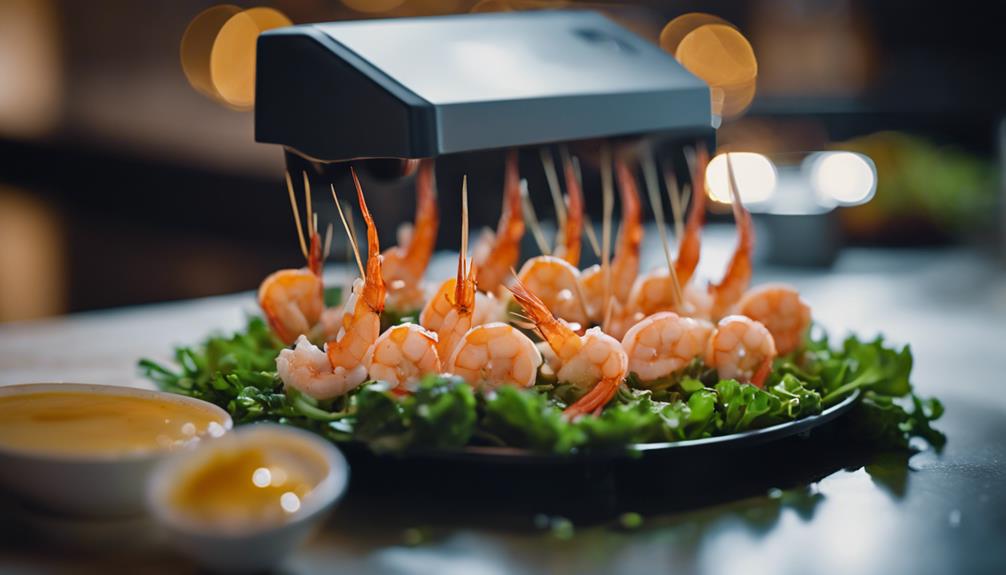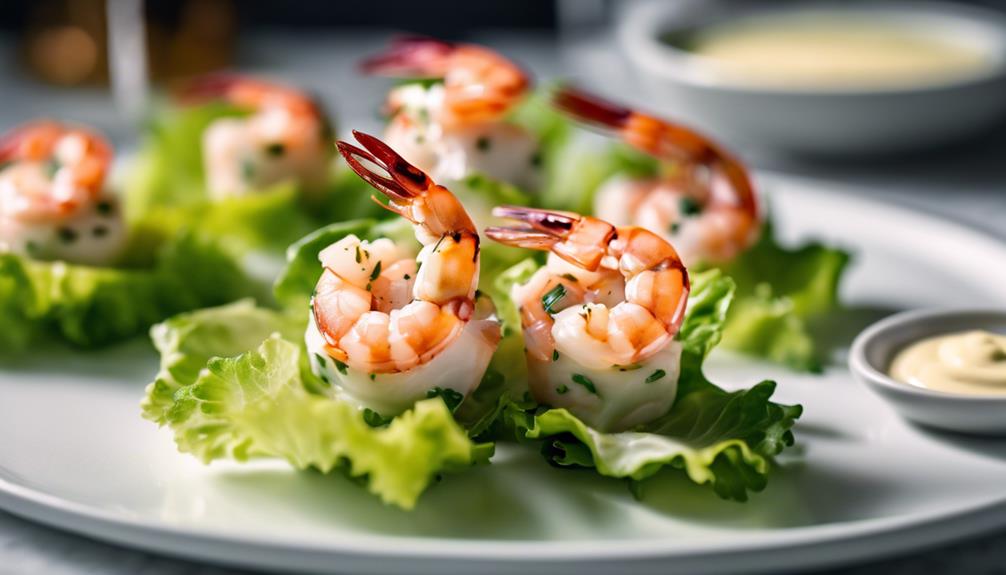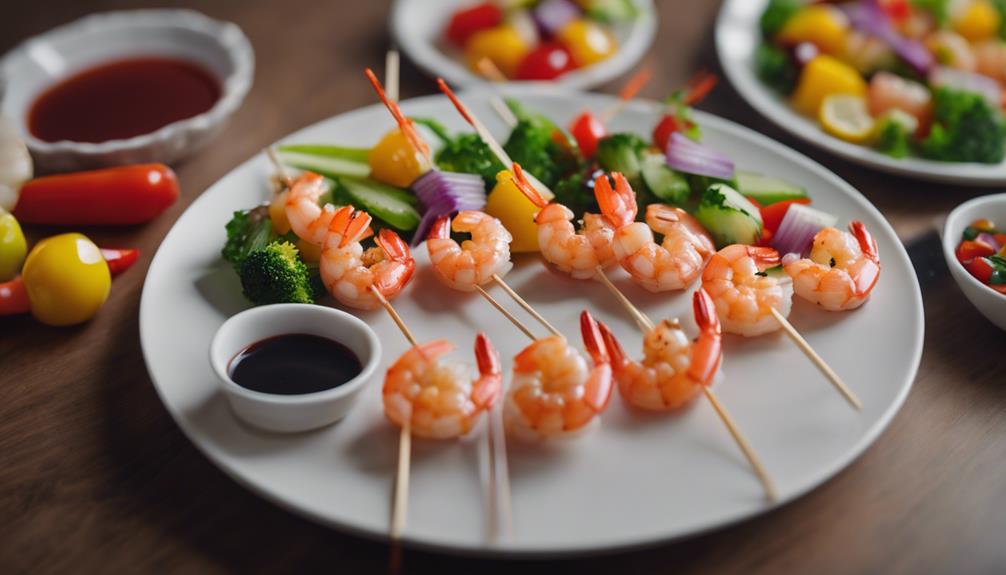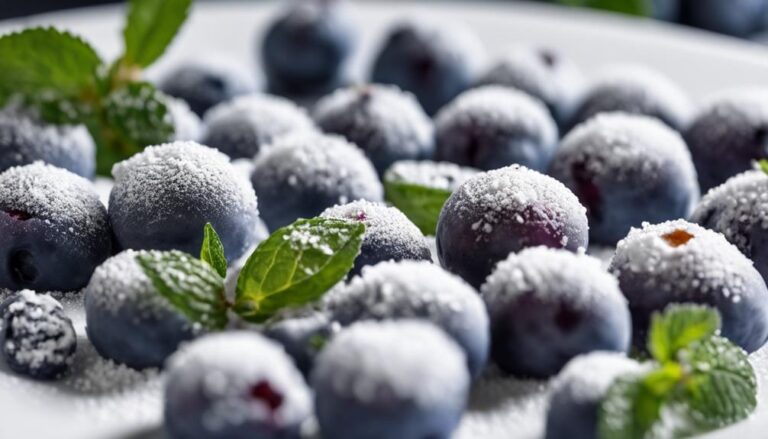Sous Vide Shrimp Bites for a Five Bite Diet Lunch
For a fulfilling Five Bite Diet lunch, master the art of sous vide shrimp bites. Seal fresh shrimp with olive oil, garlic, lemon, and seasoning in a bag before immersing in a water bath at 135°F for 15-20 minutes. This precise method guarantees tender, succulent shrimp every time. Precise temperature control and timing are essential for delectable results. Once you perfect this technique, you'll enjoy consistently delicious lunches that satisfy your cravings without compromise. Harness the full potential of sous vide shrimp bites for your Five Bite Diet rotation.
What You Will Learn Here
- Sous vide shrimp bites offer precise cooking for Five Bite Diet lunch rotation.
- Maintain tenderness with 15-20 mins at 135°F; monitor temperature for succulent results.
- Flavor infusion and consistent doneness enhance shrimp quality.
- Use fresh shrimp, olive oil, garlic, lemon, and seasonings for optimal taste.
- Mastering sous vide shrimp bites leads to consistently delicious, diet-friendly lunches.
Origin of Sous Vide Technique

The origin of the sous vide technique can be traced back to the 18th century when scientists sought precise methods for cooking food.
Over time, this method evolved, with chefs like Georges Pralus and Bruno Goussault refining the technique in the 1970s and 1980s.
Today, sous vide is widely used in professional kitchens and home cooking, offering a precise and consistent way to achieve perfect results.
History of Sous Vide
Originally developed in France, sous vide cooking traces its roots back to the late 1960s. The technique involves sealing food in airtight bags and cooking it in a temperature-controlled water bath for an extended period. This method offers several benefits, such as preserving the natural flavors and nutrients of the ingredients, resulting in tender and moist dishes.
For home use, sous vide equipment has become increasingly popular, with affordable immersion circulators and vacuum sealers readily available. These tools allow you to achieve restaurant-quality results in the comfort of your own kitchen.
The cooking process is simple: season your food, vacuum-seal it in a bag, immerse it in the water bath, and set the precise temperature and time according to the recipe.
Sous vide has revolutionized the way we cook, offering a convenient and foolproof method to create delicious meals. Whether you're a culinary enthusiast or just looking to impress your guests with perfectly cooked dishes, sous vide is a valuable technique to have in your repertoire.
Evolution of Technique
Trace back to the origins of sous vide cooking technique to understand how it has evolved over time. The concept of sous vide, meaning 'under vacuum' in French, dates back to the late 18th century, but it wasn't until the mid-20th century that it gained popularity in professional kitchens.
Initially used for food preservation, the technique has since transformed into a method known for its precision in temperature accuracy and cooking times.
Over the years, equipment advancements have played a significant role in the evolution of sous vide cooking. From basic vacuum sealers to sophisticated immersion circulators, chefs now have access to tools that guarantee consistent results and enhanced flavor profiles.
This evolution has allowed for a more widespread adoption of sous vide cooking in both professional and home kitchens, making it easier to achieve restaurant-quality dishes with minimal effort.
As the technique continues to evolve, chefs are exploring new ways to push the boundaries of flavor and texture using sous vide methods. By combining temperature control, cooking times, equipment advancements, and creative flavor profiles, the possibilities for culinary innovation are limitless.
Modern Applications Today
Explore how the origins of the sous vide technique have paved the way for its modern applications in culinary practices today. Chefs around the world are using sous vide not only for savory dishes like shrimp bites but also for innovative desserts. Sous vide desserts offer a unique texture and flavor profile, allowing for precise control over the cooking process.
Imagine a perfectly cooked crème brûlée or a silky chocolate lava cake, all achieved through the sous vide method.
Furthermore, the use of sous vide extends beyond just food; mixologists have started utilizing this technique to create one-of-a-kind cocktails with flavors that can't be achieved through traditional methods. Sous vide cocktails infuse ingredients at precise temperatures, resulting in unique and complex taste profiles.
From herb-infused spirits to fruit-flavored liquors, the possibilities are endless with sous vide mixology.
Incorporating sous vide into both sweet and savory creations showcases the versatility and precision of this cooking method, making it a staple in modern culinary practices.
Key Ingredients for Sous Vide
For successful sous vide cooking, the key ingredients that you'll need are fresh shrimp, olive oil, garlic, lemon, and a variety of seasonings.
To enhance the flavors of your sous vide shrimp bites, consider incorporating the following:
- Fresh Shrimp: Choose high-quality shrimp for the best taste and texture.
- Olive Oil: Use olive oil to coat the shrimp before vacuum sealing for added richness.
- Garlic: Minced garlic adds a savory depth of flavor to the shrimp during the sous vide process.
- Lemon: Fresh lemon zest or juice brightens up the dish and complements the seafood taste.
When preparing your sous vide shrimp bites, remember that maintaining precise temperature control is essential for achieving excellent results. Make sure you have the necessary equipment, such as a sous vide machine and vacuum sealer, to make your cooking experience smooth and successful.
Tasty Sous Vide Creations

You can explore a world of delicious possibilities with sous vide cooking. From a mouthwatering sous vide shrimp recipe to perfectly cooked sous vide lobster tail, the options are endless.
Don't forget to try a delectable sous vide scallops recipe for a gourmet culinary experience.
Delicious Sous Vide Shrimp Recipe
Indulge in the succulent flavors of sous vide shrimp with this delectable recipe for a mouthwatering culinary experience. When preparing these exquisite shrimp bites, the right seasoning and precise cooking time are vital for achieving a perfect balance of flavors and texture.
Here's how to make the most of your sous vide shrimp:
- Shrimp Seasoning:
Coat your shrimp with a blend of garlic powder, paprika, salt, and a hint of lemon zest for a burst of savory goodness.
- Cooking Time:
Set your sous vide machine to 135°F (57°C) and let the shrimp cook for 30 minutes to make sure they're tender and juicy.
- Sous Vide vs. Pan Searing:
Unlike pan-searing, sous vide cooking allows the shrimp to cook gently in their juices, preserving their natural taste and tenderness.
- Serve and Enjoy:
Once cooked, sear the shrimp briefly in a hot pan for a golden crust, then plate them with a drizzle of lemon butter sauce for a delightful finish.
Sous Vide Lobster Tail
Prepare a succulent sous vide lobster tail that promises a flavorful and tender dining experience.
- Lobster Preparation:
- Start by selecting fresh lobster tails, making sure they're cleaned and deveined.
- Season the lobster tails with salt, pepper, and a hint of lemon for enhanced flavor.
- Place the seasoned lobster tails in a vacuum-sealed bag with a drizzle of olive oil or butter to maintain their moisture during the sous vide cooking process.
- Cook the lobster tails in a water bath set to 140°F (60°C) for 45-60 minutes to achieve the perfect texture.
- Sous Vide Tips:
- Ensure the lobster tails are fully submerged in the water bath to guarantee even cooking.
- Use a kitchen thermometer to monitor the water temperature throughout the cooking process.
- Finish the lobster tails by searing them in a hot pan for a crispy exterior before serving.
- Pair the succulent sous vide lobster tails with a buttery garlic sauce or a squeeze of fresh lemon juice for a delightful dining experience.
Sous Vide Scallops Recipe
For those seeking a delectable seafood dish with a tender texture, consider trying out a flavorful Sous Vide Scallops recipe. When prepared using sous vide techniques, scallops retain their natural juices and flavors, resulting in a mouthwatering appetizer that will impress your guests.
Here are some tips to make the most of this delightful dish:
- Choose Fresh Scallops: Opt for fresh, high-quality scallops for the best taste and texture.
- Season Lightly: Enhance the natural sweetness of scallops with a simple seasoning like salt, pepper, and a squeeze of lemon.
- Precision Cooking: Sous vide guarantees precise cooking at the perfect temperature, ensuring tender and succulent scallops every time.
- Quick Sear: After sous vide cooking, give the scallops a quick sear in a hot pan for a golden crust while keeping the insides moist and tender.
Experience the benefits of sous vide cooking with this scallops appetizer that promises to delight your taste buds with each bite.
Sous Vide Timing Tips
To guarantee your sous vide shrimp bites turn out perfectly, pay close attention to the timing. This is essential for achieving the desired texture and doneness.
Precision temperature control and cooking times are key to evenly cooked and delicious shrimp bites.
Timing for Perfect Texture
Achieving the perfect texture for your sous vide shrimp bites involves precise timing to guarantee a tender and flavorful result. To achieve the ideal sous vide shrimp texture, it's important to adhere to the optimal cooking time.
For shrimp bites that are succulent and juicy, aim for a cooking time of around 15-20 minutes at a temperature of 135°F (57°C). This timeframe allows the shrimp to cook through gently while preserving their delicate texture.
Overcooking shrimp can lead to a rubbery and tough consistency, while undercooking can result in a raw or mushy texture. By following the recommended cooking time closely, you ensure that the shrimp reach the perfect doneness without losing their natural sweetness and tenderness.
Keep in mind that precise timing is key when it comes to sous vide cooking, as even a few minutes can make a significant difference in the texture of your shrimp bites. Mastering the timing for perfect texture will elevate your sous vide shrimp bites to a delightful dining experience.
Precision Temperature Control
Maintain precise control over the temperature when sous vide cooking shrimp bites to achieve consistent and ideal results. Temperature accuracy is essential for cooking perfection. To guarantee your shrimp bites turn out just right, set your sous vide water bath to the exact temperature specified in your recipe, typically around 135°F to 140°F for shrimp. Invest in a reliable sous vide machine with precise temperature controls to ensure accuracy.
Before placing the shrimp in the water bath, double-check the temperature using a separate thermometer to verify the accuracy of your sous vide device. Even a slight difference can affect the outcome of your dish.
Once you're certain the water is at the correct temperature, gently submerge the sealed bags of shrimp into the bath and let them cook for the recommended time.
Ensuring Even Cooking
Guarantee consistent and thorough cooking of your sous vide shrimp bites by adhering to precise timing guidelines throughout the cooking process. Maintaining temperature consistency is essential to make sure that your shrimp bites cook evenly. Set the water bath to the recommended temperature and monitor it regularly to prevent fluctuations.
Cooking time plays a significant role in achieving the desired texture control. Follow the suggested cooking times closely to avoid undercooking or overcooking your shrimp bites. This precision will help you achieve perfectly cooked shrimp with a tender yet firm texture.
Moreover, controlling the cooking time also aids in flavor infusion. The duration for which the shrimp are cooked in the sous vide bath allows the flavors to penetrate the meat thoroughly, enhancing the taste of the final dish. By adhering to the recommended cooking times, you can ensure that the shrimp bites aren't only evenly cooked but also bursting with delicious flavors.
Paying attention to both temperature consistency and cooking time will result in shrimp bites that aren't only perfectly cooked but also infused with mouthwatering flavors.
Final Thoughts

Considering the simplicity and flavor-packed outcome of these sous vide shrimp bites, you'll likely find them to be a satisfying addition to your Five Bite Diet lunch rotation.
The benefits of preparing these shrimp bites using the sous vide method are numerous. You can achieve precise cooking results, ensuring that each bite is perfectly cooked without the risk of overcooking. This method also allows you to infuse the shrimp with your favorite seasonings, enhancing the overall flavor profile of the dish.
However, there are some challenges to keep in mind. Sous vide cooking requires precision temperature control and a longer cooking time compared to traditional methods. This may require some adjustment to your meal planning and preparation routine.
Despite these challenges, the potential for success with sous vide shrimp bites is high. With practice, you can master this cooking technique and create consistently delicious shrimp bites for your Five Bite Diet lunches.
Frequently Asked Questions
Can I Use Frozen Shrimp for Sous Vide Shrimp Bites?
Yes, you can use frozen shrimp for sous vide shrimp bites. To guarantee even cooking, thaw them properly before sous vide. Pair with complementary flavors like garlic and lemon for a delightful taste. Texture preferences can be adjusted by cooking time.
What Is the Best Way to Store Leftover Sous Vide Shrimp?
To keep leftover sous vide shrimp fresh, store them properly in an airtight container in the fridge. For longer preservation, freeze them. When ready to enjoy again, reheat gently to maintain their tenderness and flavor.
Can I Add Additional Seasonings to the Sous Vide Shrimp Bites?
Yes, you can definitely add additional seasonings to your sous vide shrimp bites to enhance the flavor. Experiment with different spices and herbs to elevate your dish. Sous vide techniques allow for easy flavor experimentation, giving you endless cooking methods for your shrimp alternatives.
How Long Can I Keep Cooked Sous Vide Shrimp in the Fridge?
To maintain peak freshness, store cooked sous vide shrimp in the fridge for up to 3 days. Guarantee food safety by refrigerating promptly. Proper shrimp storage is essential for enjoying delicious meals while prioritizing health and well-being.
Can I Use a Regular Ziplock Bag for Sous Vide Cooking?
You should use proper equipment for sous vide cooking, like a designated bag. Regular ziplock bags may not withstand the heat, leading to safety concerns. Make sure you have the right tools to serve delicious meals safely.
Conclusion
To sum up, sous vide shrimp bites are a delicious and healthy option for a five-bite diet lunch.
By utilizing the sous vide technique, you can guarantee that your shrimp is perfectly cooked and full of flavor.
With the right ingredients and timing, you can create a tasty meal that's both satisfying and nutritious.
Consider adding sous vide shrimp bites to your lunch rotation for a flavorful and convenient option.











